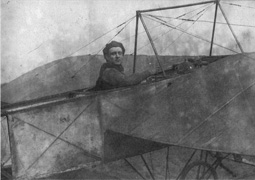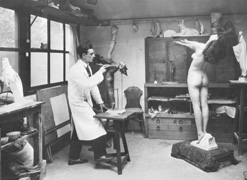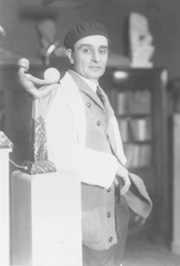PREAMBLE
The term Art Deco derives from the 1925 "Exposition Internationale des Arts Decoratifs Industriels et Modernes", (International Exposition of Modern Industrial and Decorative Art) which was held in Paris.
That exhibition gathered 21 different countries and welcomed more than fifty million visitors.
During the exhibition, Max LE VERRIER received a gold medal.

Art Deco, which is widely considered to be an eclectic form of elegant and stylish modernism, was influenced by a variety of sources - among them were the so-called "primitive" arts of Africa; as well as historical styles such as Greco-Roman Classicism; and the art of Babylon, Assyria, and Ancient Egypt- updated by aerodynamic designs.
At that time, the women’s liberation movement was making significant progress.
Bobbed hair and short skirts (to dance the lively Charleston) characterized the iconic figure of the “flapper” called garçonne in French ("boy" with a feminine suffix).
The famous women closely identified with this style were Suzanne LENGLEN (tennis champion and symbol of the graphic design movement), Tamara de LEMPICKA (painter), and Joséphine BAKER (dancer)…
The famous CLARTE by Max LE VERRIER, created in 1928, is also a perfect illustration of the « garçonne ».
This new “in motion”, slim and slender, shortly dressed, female silhouette, was an important source of inspiration for Max LE VERRIER when created his collection of dancers, gymnasts, and Art Deco lamps.
He continued to work on this theme and one concerning animals using a precise linear fluidity and simple shapes.
The captivating beauty of his creations, not only can be judged by the extreme detail of the hands and faces sculpted, but also by the elegance and charm of the poses of his sculptures.
When I work on a piece of his art, I am under the impression that it is a precious witness of that fascinating period.
CHILDHOOD AND YOUTH
 Louis Octave Maxime LE VERRIER was born in Neuilly sur Seine on January 29, 1891. Louis Octave Maxime LE VERRIER was born in Neuilly sur Seine on January 29, 1891.
His mother was Belgian and his father was a Parisian goldsmith and jeweler on Boulevard Malesherbes in Paris.
His parents divorced when he was 7 years old.
He attended several boarding schools (Collège de Verneuil sur Avre) and was a brilliant student.
His interest in drawing and sculpture occurred early, and he practiced his craft on wooden rulers, which he turned into little houses, churches, and other small items.
His father thought that his future would be in farming, therefore he sent Max to study agriculture (St Sever and La Réole) against Max’s wishes. However, Max LE VERRIER kept alive his liking for sculpture during his spare time.
At the age of 16, he returned to Paris and did odd jobs to escape farm-work and to provide for himself. (His father emancipated him, and, as a result, he was left to fend for himself).
In 1909, when he was 18, he left for England. As a foreigner, it was very difficult for him to find a job in London; refusing to come back to France and admitting defeat, he lived very difficult days.

During the epic aviation era, which fascinated all the youth of that time, he met a
Frenchman named JAMESON who bought a plane on credit, and,
together, they opened an aviation school in Rendon.
The business was difficult. JAMESON gave his way to a rich, well-off Englishman
named George LEE TEMPLE. Max LE VERRIER repaired and perfected the aircrafts
and engines.
Illegally, he practiced flying on Bleriot (type « Traversée de la Manche »),
and then on Breguet, making some successful flights, and he received his
pilot’s license in 1913.
MILITARY SERVICE – WORLD WAR I
Max LE VERRIER was requested in France for his military service after being granted an extension of one year. He was assigned to the Cherbourg fortress artillery. He applied for admission to the aircraft unit several times.
At the beginning of the war, there were few civilian pilots. Max LE VERRIER was sent to Pau, where he received his military pilot’s license. Then, as part of a bombing squadron, he was sent to the front lines in February of 1915 to Voisin.
On May 25th of 1915, he was shot down by two German fighter planes during an air battle. His fighter was riddled with bullets, and his engineer was killed behind him. Fortunately, he was not hurt but managed to land behind the enemy lines and was classified as “missing in action”. He received the Military Medal posthumously and the Croix de Guerre 14-18.
Max LE VERRIER was sent to a prisoner of war camp in Munster, in Westphalie (German region), where he stayed 3 years.
As he was a pilot and non-commissioned officer, he was not forced to work; he asked for tools and modeling clay and began sculpting seriously.
He made friends with other artists in the camp, such as BARDIN, a wood carver. He portrayed mates, and created a statuette of a Russian. From time to time, the professional and amateur artists of the camp held an art exhibition.
In the beginning of 1917, he was luckily designated to go to an interment camp in Switzerland (prisoner trade).
He went to the Beaux Arts school in Geneva to the GUIBERT’s atelier, and made friends with skilled sculptors like Pierre LE FAGUAYS, BOURAINE- painters and draftsmen- who would later become his very good friends and with whom he would create pieces of art.
Enjoying an atelier and models, he created statuettes –nude women for the majority- in terra cotta:
« Souvenir », « Confidence ».
CARREER
Max LE VERRIER returned to Paris after the November 11th 1918 armistice with little means, but with a huge independent spirit. From that time forward, he would devote all of his life to sculpture.

He rented an artist atelier “Rue du Théâtre”, where he worked 12 hours per day.
He made some terra cotta pieces of art, and carved his first sculpture, the famous PELICAN in a very
1925’s style (Sculpture giving a hacked effect). This sculpture, signed ARTUS (Max LE VERRIER’s pseudonym), had great success and was at the
foundation of his workshop created in 1919. He made everything on his own, from the creation
(the founding, chaseling, patina) to the selling of his pieces of art.
In 1921, he married Jeanne HUBRECHT. The following year, his first son, Jean Paul, was born and his second son was born in 1930.
Rue du Théâtre would later expand with the purchase of a small house (Mimi Pinson style), in the rear of a garden colonized by cats, which inspired his “SITTEN CAT”.
Then, he created a collection of animals inspired by zoos and circuses (“Jardin des Plantes”, “Bouglione Circus” in the “Jardin d’Acclimatation” in Boulogne wood).
 |
 |
He sculpted a large stork; a squirrel, in a cubist trend; as well as panthers (“BAGHERA”); chimpanzees (“LE SINGE AU PARAPLUIE”); horses; lions…, together with famous animal keepers such as POMPON (triumph in 1922 with the White Bear exhibited in the “Salon d’Automne”), HERNANDEZ, and DELHOMMEAU.
At the same time, he carved many motoring mascots, which were popular at that period- in particular, the “EOLA”, replica of the Rolls Royce.
The profit made from his first creations allowed him to hire workers trained by himself and a sales representative.
He founded his own society in 1926. His collection was already substantial- that was the American time, the golden age until 1929.
Max LE VERRIER sculpted many statuettes, men, and dancers.

In 1928, he carved from a live model, his famous CLARTE, the woman with a lighted ball,
the main piece of art of his collection. In fact, he needed 3 different models: one for the
head, another one for the chest, and one for the legs. For this last part, he asked an
African-American woman playing in Josephine BAKER’s ballets to pose. A very 1930’s
candle stand, taking back the idea of an antique goddess of light, symbolizing the era
with a boyish hairstyle but also by the sedateness of her figure,

The CLARTE was displayed in the exhibition « LUMIERES » -Lights- at the Georges Pompidou
Center from May to August 1985 but also in 1987 the exhibition « MADE IN FRANCE » at Harrod’s
in London and in the exhibition « DE MAIN DE MAITRE » at the Grand Palais in Paris.
It was also exhibited in the MARTINEZ hotel in Cannes in 2000.
Today, two of them can be admired at the LUTETIA hotel in Paris.
Max LE VERRIER then made ceiling lights, wall brackets, lamp bases, and bookends.
He also created his friend’s sculptures: Pierre Le FAGUAYS, (some of his sculptures are signed FAYRAL or GUERBE, his pseudonyms) famous for his elegant dancers; BOURAINE, also talented but died young; MERIADEC; JANLE; and others.

The Maison Max LE VERRIER grew throughout the years. Max LE VERRIER hired a
secretary and one accountant, representatives for several firms, and he turned his
personal business into an LLC (1928).
The atelier located on Rue du Théâtre and the neighboring habitation house were
used as offices and a show room. The production moved to « 90 rue des Entrepreneurs » in
the 15th district.
In 1933, he bought land in the heart of old Montparnasse, in the 14th district, 30 Rue Deparcieux, in the back of the blind alley, in a green setting.
He deserted the Rue des Entrepreneurs to settle the production workshop on Rue Deparcieux.
Finally, in 1938, he decided to centralize everything there: his own studio, the production workshop, the founding, the office, the showroom, the stocks, and his apartment.
When the Second World War broke out, he had been settled for 8 months.
WORLD WAR II
During the Occupation, he continued his work of art while facing many challenges (lack of everything at that time).
He joined the Resistance (his house was a memorial place and served as a “mailbox” for the Resistance) and was arrested by the members of PETAIN Militia.

He was held captive for four days in their cellars and handed over to the German soldiers and was finally released. However, a few days later, the Militia returned to his house a second time.
He managed to run away, owing to a hidden door, whose entrance was located on “Rue Daguerre”.
This door had been built so the people working illegally– Jews or those who were not working for the German “STO” (Obligatory Labor Service) could escape.
With a fake identity, he lived at a friend’s place in Paris, and managed to go to Gers (a region in the South of France), where he owned a house and where his wife and his two sons were living.
In that large house, they would put many people up during the war, giving them the benefit of the farm food, and they would help some war prisoners (Correspondance, parcel-sending…).
At that time, his eldest son, Jean Paul, was a student at L’Ecole des Beaux Arts in Toulouse, making part of the classroom number 42, which was totally committed to the military service in Germany.
He took another name to escape it.
Max LE VERRIER returned to Paris in September of 1944 to find his apartment, his workshop, and his showroom completely sacked by the Militia (office furniture, statuettes, typewriters, furniture, silverware, clothes, etc… had all disappeared)
The looting was stopped by the Parisian Police and he would later find some furniture and other belongings owing to his friend Pierre BOURSICOT, who became the national safety boss, in a warehouse which stocked many items seized from the Militia members’ houses.
AFTER THE WAR
At the end of the war, Max LE VERRIER re-opened his workshop. Slowly, life returned to normal.
The main bronze editors almost died. Mr. LEHMANN died at a concentration camp, and Mr. GLODSHEIDER was ruined.
Max LE VERRIER re-started the carving of the statuettes in bronze and art cast, and focused his creation on bronze items: boxes; ashtrays; office items; religious items; medals inspired by antique or medieval masterpieces, town arms, and by the Loire castles, cathedrals, museums, and private collections.
He was assisted by some skilled workers and by his foreman, Mr. MARSAILLE (who won a golden work medal). His wife and his two sons also worked for him.
As a tireless sculptor, he created another animal collection in bronze in a smaller size (Birds, Rhinoceros, Donkey, Goat, Bear, Sea Lion, and a characters group: DON QUICHOTTE AND SANCHO PANCA).
Until his last breath, he sculpted and finished in his hospital bed a little panther three days before dying, on June 6th 1973. He was 82.
He was buried in Fontenay les Bris Cemetery, near his friend LE FAGUAYS who had died 10 years earlier.

Jean Paul LE VERRIER (1922- 1996) went on his parents’s company. He studied drawing and sculpture at the Beaux Arts school in Toulouse, from 1939 to
1943. (He received an award “Prix de la peinture” in 1943 ) and at the Beaux Arts school
in Paris from 1945 to 1949. He was an interior designer for exhibitions and designed French pavilions for
International fairs. At the same time he kept painting and sculpting.
He made
humorous drawings, created a lot of posters, and after his father’s death, realised
humorous bronze sculptures. (« OURS » , « CHAT A LA BOULE », « CHAT GUERIDON »),
ashtrays, book-ends (« TEQUEL »)…
Jean Paul LE VERRIER was extremely attached to all his father work and style
conscious to pursue it. Thus he teached me the craft and handed me down his
passion.

HOMMAGE TO MAX LE VERRIER

Max LE VERRIER was a sensitive man who had a sense of beauty and esthetics. He was fascinated
very early by sculpture and dedicated all of his life to it. He had endlessly worked during the day,
and often very late at night, even on vacation. He would never move without a sculpture to create or
finish. He had for his handcraft, the love of the creator.
During all his life and particularly during his youth, he felt a sense of frustration, because he did not
have a normal familial life during his childhood, and had to stop studying. As a result, he could not
gain general knowledge in relation with his ability and his social rank. But owing to his intelligence,
his bravery, his tenacity, his independence, his intellectual curiosity, his many and various centers of
interest, he was self-educated.
Gifted by a practical sense, and helped by the different experiences he had during his youth
(as well as in mechanics, electricity, casting or chaseling), not only could he tackle problems
concerning the creation of his sculptures but also the ones relating to their realization, and resolve them alone.
 With a lot of patience, he fought to create and assume everything alone since the beginning, and ended to With a lot of patience, he fought to create and assume everything alone since the beginning, and ended to
have many collaborators.
In addition, he had an admirable sense of friendship and solidarity; he was an appreciated and admired
man.
Today, Max LE VERRIER is famous in France and all over the world. (GERMANY, ENGLAND, BELGIUM,
SWITZERLAND, USA, SPAIN etc…)
His work is prodigious, not only by the countless sculptures and different items made but also by the wide
range of themes, by his ability to accommodate modernism and tradition, and by the movement he knew
to give to his work.
When my grandfather, Jean Paul LE VERRIER, died in 1996, I decided to go on the family company.
Unfortunately, we had to sell the workshop “Rue Deparcieux » (to be able to pay the inheritance tax)
and move to the suburb because of the high cost of rent in Paris.
In spite of this, and despite facing new challenges (finding skilled workers, the high expenses, fighting
against counterfeit, etc…), the company is still alive and flourishing, with respect and according to
Max LE VERRIER, his wife, and his son Jean Paul’s wishes, expressed by each one, before their deaths.
Thus, the Maison Max LE VERRIER remains the tangible memory of a time and maintains emotional
inter-generational ties.
I deeply thank my forbearers for all the wonderful and exceptional things they have left me.
Damien Blanchet LE VERRIER
Great grandson of MAX LE VERRIER
|